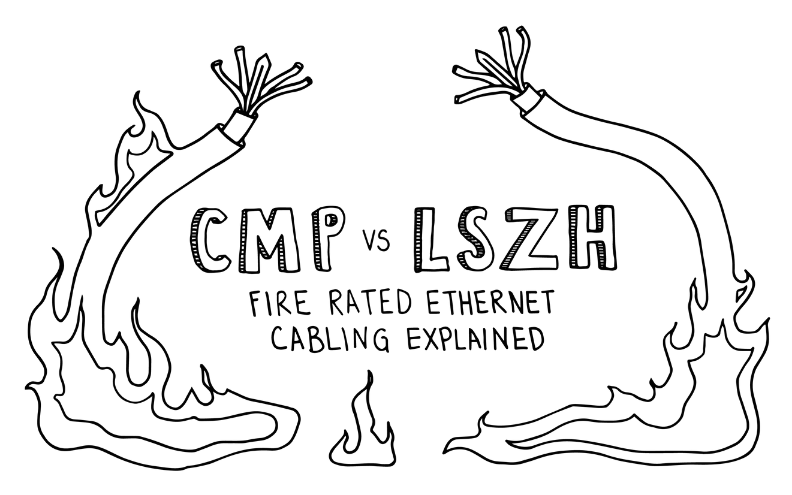Payment methods accepted

CMP vs LSZH: Fire Rated Ethernet Cabling Explained
Written by Don Schultz, Technical Sales Representative and Fluke Networks Certified Technician
Fire. We could not have survived to this point without it. For thousands of years we have used it to cook, heat our homes, generate energy, provide light, and more. Fire is a powerful ally. When misused, or allowed to get out control, fire is simultaneously a powerful enemy capable of destroying and causing great bodily harm.
Today we will be talking about two competing fire ratings you are likely to see stamped onto an Ethernet cable jacket. This is important, as one is far more effective than the other. Read on to avoid getting burned!
In today’s commercial buildings, oftentimes the plenum space is used to move air around for circulation. The plenum, or HVAC space, is often found below raised floors or above suspended ceilings. In a tight confined space, fire can propagate quickly. Complicating matters, these confined spaces are used to channel air conditioning and heat. When fire ignites, smoke usually follows. Smoke is typically toxic to living organisms and some kinds of smoke are more toxic than others.
A likely spot to run Ethernet data cabling is the plenum space. Ethernet data cable has flexible cable jacket material made out of plastic; specifically PVC or polyvinyl chloride.
Smoke emitted by untreated burning PVC is extremely toxic, and the last thing you want your ventilation system bringing into your work space is flames and smoke at a very high speed.

A plenum is any enclosed area that facilitates environmental air handling like an air conditioning duct or an air routing drop ceiling. It can be any air space between walls, under floors, or dropped ceilings.
Enter Firing Ratings
Given the safety risks associated with running PVC clad cabling through a building, a safer plastic jacket was necessary.
In 1979, British Research Engineering developed the LSZH cable jacket (Low Smoke Zero Halogen) for use in commercial plenum spaces, submarines, and nuclear power plants. This jacket type was developed in and used by European countries and further adopted by Asian countries. PVC was combined with additives to make it less...offensive.
Simultaneously, in the late 1970s the search for these same attributes began in the United States at Underwriters Laboratories (UL). The result was the development of the UL910/NFPA 262 test for fire safety in commercial plenum air spaces. In the early 1980s, the plenum rated cable standard (CMP) was developed and incorporated in the NEC or National Electric Code under section 90A.
The aim was to address:
- Toxic smoke due to burning PVC
- Flame retardance, so that the cable itself did not make the fire worse
- Flame resistance, so that the cable was less likely to start burning in the first place
So, we had two competing standards. This normally might not be an issue, but LSZH cable jackets do not entirely satisfy the ultimate goal of a safer cable jacket. The reason has to do with the additives to the PVC plastic not aging well, or performing differently under real world conditions versus laboratory testing.
CMP rated cable jackets use different additives, to the point where less than 50% of the cable jacket by weight is plastic. A large amount of the additive is Teflon. If you have ever wondered why plenum rated cable feels different from riser or plain CM rated cabling, that is why.
In order for an Ethernet data cable to be acceptable for commercial plenum use in the United States, it must be CMP rated in accordance with UL910/NFPA 262 protocols.
So, which cable jacket comes out on top when it comes to fire safety? Well, BER or British Engineering Research did some tests. All pictures are courtesy of Fire Performance of Data Communication Cables as published by The Society of the Plastics Industry, Inc.
Here is the flame promotion result:

Here is the smoke volume result:

As the two illustrations make clear, LSZH is no substitute for plenum rated cable. LSZH may be a safer alternative to outdoor (CMX) cable jackets being used indoors, but right now that is all it has going for it.
Now, we know that LSZH does not live up to expectations in regards to spreading fire or the amount of smoke generated. Just how toxic is the smoke when these cables burn? The toxicity in this case is demonstrated by carbon monoxide found in the smoke:

Ok, so LSZH must be better at stopping a fire in the first place. Right? Well…

When CMP burns, this is how hot it gets in an enclosed space like a plenum area. Approximately 350 degrees C or 662 degrees F.

When LSZH burns, this is how hot it gets. Yes, that is showing an unreal 800 deg C or 1,472 deg F. This is enough to melt many metals, and distort steel building frames.
So, now you know how LSZH performs in comparison to CMP rated Ethernet cable. The main takeaway is that you don’t dare use LSZH as a substitute for CMP and never ever use CMX in large quantities inside a commercial building!
Happy Networking!
trueCABLE presents the information on our website, including the “Cable Academy” blog and live chat support, as a service to our customers and other visitors to our website subject to our website terms and conditions. While the information on this website is about data networking and electrical issues, it is not professional advice and any reliance on such material is at your own risk.



































